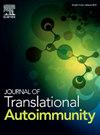Autoantibodies in systemic sclerosis: From disease bystanders to pathogenic players
IF 3.6
Q2 IMMUNOLOGY
引用次数: 0
Abstract
Autoantibodies (Aab) are recognized as key indicators in the diagnosis, classification, and monitoring of systemic autoimmune diseases (AID). Recent studies have expanded knowledge through the discovery of new antigenic targets, advanced methods for measuring Aab levels, and understanding their possible pathogenic roles in AID. This narrative review uses systemic sclerosis (SSc) as an example to highlight the importance of Aab associated with HEp-2 immunofluorescence assay positivity (traditionally referred as antinuclear antibodies [ANA]), exploring recent developments in the field. Firstly, we outline the various types of ANA found in SSc and their links with specific disease features. Newly discovered antibodies shed light on SSc cases where Aab had previously gone unidentified. Secondly, we emphasize the necessity for novel quantitative techniques to track Aab levels over time by gathering data regarding the timing of Aab occurrence relative to SSc symptoms and the relationships between Aab concentrations and disease severity. Finally, we discuss the experimental findings suggesting a potential direct role of Aab in the development of SSc. The advancements surrounding Aab provide insights into new disease mechanisms and may lead to innovative diagnostic and treatment approaches.
系统性硬化症的自身抗体:从疾病旁观者到致病参与者
自身抗体(Aab)被认为是诊断、分类和监测全身性自身免疫性疾病(AID)的关键指标。最近的研究通过发现新的抗原靶点、测量Aab水平的先进方法以及了解其在AID中可能的致病作用,扩大了知识范围。本文以系统性硬化症(SSc)为例,强调Aab与HEp-2免疫荧光检测阳性(传统上称为抗核抗体[ANA])相关的重要性,探讨该领域的最新进展。首先,我们概述了在SSc中发现的各种类型的ANA及其与特定疾病特征的联系。新发现的抗体揭示了Aab以前未被识别的SSc病例。其次,我们强调需要新的定量技术,通过收集与SSc症状相关的Aab发生时间以及Aab浓度与疾病严重程度之间的关系的数据来跟踪Aab水平随时间的变化。最后,我们讨论了提示Aab在SSc发展中的潜在直接作用的实验结果。围绕Aab的进展提供了新的疾病机制的见解,并可能导致创新的诊断和治疗方法。
本文章由计算机程序翻译,如有差异,请以英文原文为准。
求助全文
约1分钟内获得全文
求助全文
来源期刊

Journal of Translational Autoimmunity
Medicine-Immunology and Allergy
CiteScore
7.80
自引率
2.60%
发文量
33
审稿时长
55 days
 求助内容:
求助内容: 应助结果提醒方式:
应助结果提醒方式:


